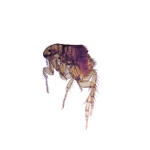FYI: If you buy something through a link on this site I may earn a commission - at NO extra cost to you.
Dealing With Fleas And Ticks
Fleas and ticks can make your puppy or dog miserable... they can also trigger allergies and make him sick.
If your puppy is always scratching or has red, irritated patches of skin, and you see what looks like black grit in his fur (especially around the neck, ears, base of tail and groin) - chances are he has some fleas.
You may even see the fleas themselves as they crawl, or jump, around in his fur.
Ticks are very tiny BEFORE they snack on your dog's blood, but become fat and engorged afterwards and are pretty easy to spot. If you also see some small (or not-so-small) 'wart-like growths' on Fido's head/body, they are quite possibly ticks.

About Fleas on Dogs
Fleas are tiny, six-legged, reddish brown bugs but they're very athletic! They can jump almost a foot straight up, and cover 4 - 6 inches in distance.

There are four stages in the life-cycle of a flea - egg, larvae, pupae and adult (adults only make up about 5% of the total flea population in any one environment).
Fleas breed at incredible speed and, left to their own devices, a few fleas can turn into a major infestation in a very short space of time.
Most fleas only live for between 3 and 6 months (but in ideal conditions could live for over a year) and during that time a female flea could lay 2000 eggs!
Fleas have the potential to make your pet sick, spreading diseases such as Lyme Disease, Ehrlichiosis and Rocky Mountain Spotted Fever.... and these illnesses can be transmitted to humans too.
They can also cause carry, and transmit, tapeworm larvae to your dog.
Some pups or dogs are so sensitive to flea saliva that the bites set up an allergic reaction.
When you realize that a flea can bite up to 400 times a day you can imagine why a flea-saliva allergy can make your poor dog very uncomfortable.
Flea allergies cause intense itching, pain, swelling, hot-spots or bleeding/scabbed areas.
Even young puppies can have fleas if their momma or their environment was infested. If Fido has fleas you need to kill them at ALL stages of development to get the results you want.
There are a few places on Fido's body to check first if you're looking for fleas/ticks.
The little critters prefer areas which are nice and warm, possibly moist, and also where the skin is thinner or major blood-vessels lie.
Fleas and ticks are likely to congregate on these areas of your dog:
- Belly, groin, genital area
- Armpits
- Around the neck and/or under the collar
- Above and below the tail
If you can't easily see flea or flea dirt, and/or your dog has a long or thick coat and you're not sure whether or not he has fleas, stand him on white, or light colored, sheet and comb through his coat carefully with a flea comb.
Even if you don't immediately see fleas in the teeth of the comb, black gritty material is likely flea feces.
If these small black flecks fall onto the sheet and turn red when wetted-down then they're confirmed to be flea-dirt (the red is your dog's blood).
If Fido has a lot of fleas, they may also fall (or jump) off onto the sheet.
Over-the-counter medications are not as effective (or safe) as the ones recommended or prescribed by your veterinarian, so don't waste money, or take risks with your pup's health, by using OTC chemically-based products.
However, even veterinarian prescribed/recommended flea and tick medications/products can cause side effects, some of which can be serious.
Possible adverse reactions which Fido may have to dog flea/tick products include:
- Excessive salivation
- Diarrhea and/or vomiting
- Itching
- Hair Loss
- Nervousness or anxiety
- Shaking or trembling
- Loss of co-ordination or muscle control
- Seizures
- Death
You can find out everything you need to know about the active ingredients in flea/tick products (including potential dangers) here: National Pesticide Information Center - Specific Chemical (Active Ingredient) Information.
Some flea/tick products only kill fleas (or even just adult fleas, leaving eggs and larvae undamaged), others only ticks, some
kill fleas and ticks, some kill fleas, ticks and internal parasites such
as certain types of worms, others also repel mosquitoes.
Some popular flea & tick preventatives
If your dog has been the host to a bunch of fleas it's vital to treat her bedding, the carpet and any soft furnishings she's been in contact with as well as your yard/garden.
This way you will make sure to kill fleas at all life stages and put an end to the problem properly.
You can buy special sprays or use one of the popular 'bombs' (a pressurized can of chemicals that spell D-E-A-T-H to fleas such as Virbac Knockout ES Area Treatmentand/or Virbac Home Flea Relief Yard Spray Concentrate) which are very effective.
By treating both your puppy and your environment you stand the best chance of being free of fleas and ticks in a very short period of time.
Be sure you're using the most effective, and safest, products for your dog and see many more options by checking out this page.... Best Flea Medicine For Dogs
About Ticks On Dogs
Ticks are small, brown or black creatures with teardrop-shaped bodies and 8 legs (they're related to spiders - another critter that makes you go "yuk"!).
Ticks vary in size from tiny, pin-head critters to much larger one - sometimes as large as a kernel of corn, especially when they're full of blood.
The most common ticks in the USA is the brown dog tick and the American dog tick. The Deer tick (the variety most likely to carry and transmit Lyme Disease) and the Western Black-legged tick can also be found.


The first photo shows what a tick might look like before it bites your pup and starts to feed. The second photo is what the same tick looks like once it's engorged with your pup's blood. Ugh, nasty!
In addition to spreading diseases, ticks can almost literally suck the life out of your dog/puppy. A severe tick infestation can remove so much blood from his body that he becomes anemic, and this has the potential to be fatal.
Occasionally a tick can cause your dog to become (temporarily) paralyzed. This happens when a female tick releases a toxin into your dog's system while feeding.
If your dog shows sudden or unexplained weakness or paralysis, check him THOROUGHLY for ticks. They can be easy to miss at times. If the paralysis is caused by a tick, once it's removed your dog should make a full recovery.
The best, most effective and safest way to prevent or kill ticks is to use amedication specifically designed to kill fleas and ticks.
Over generations (which isn't very long for such short-lived creatures) fleas and ticks are able to build up an immunity to chemicals and pesticides they're exposed to on a regular basis.
This means that a product that once worked well, may no longer be so effective.
To keep your dog safe it can be sensible to switch up your product choices every now and then, under the direction and suggestion of your veterinarian of course.
There are also other alternatives to chemical-based flea and tick medications, such as natural dog flea control products and home remedies for fleas (both for prevention and treatment).
These are safer than chemicals and can be very effective when used regularly.
For dogs or puppies with a severe infestations it may be necessary to use a vet-recommended product to knock down the numbers before switching to more natural options, but every situation varies.
How To Remove A Tick From A Dog
Symptoms can progress very quickly, so getting help as soon as you realize something isn't quite right is hugely important. Of course, this applies to all diseases and conditions, the earlier you get an evaluation and treatment plan in place, the faster your dog will recover.
Blood can't be tested for Lyme until three to five weeks after a suspicious tick bite, as it takes that long for antibodies to be produced and show up in the blood stream.
The most commonly used antibiotics used for treating Lyme Disease in dogs is Doxycycline. Other antibiotics including Amoxicillin may also be used. Sometimes anti-inflammatory medications are also given to reduce swelling and discomfort.
Antibiotic treatment is usually given for at least three weeks, often four. Prompt diagnosis and treatment gives your dog the best chance of making a full recovery but Lyme disease can be tricky and symptoms can improve, and then worsen over time. However correct antibiotic treatment significantly reduces your dog's chances of developing severe or chronic lyme-related issues later on.
Symptoms generally improve quickly once antibiotics are started. If you don't see a noticeable change in your dog within 3 - 5 days, take him back to your veterinarian for another evaluation. He may need a different medication or an additional one.
The earlier the antibiotics are started, the better the chance that your dog will make a full recovery. As always, it's important to finish the entire course of antibiotics because if they're stopped too early, symptoms may come back (along with the risk of the long-term damage).
Sticky Lint Roller Tick Removal
Carrying a sticky lint roller (the type with tear-off sheets) in your car, or in your coat/bag etc. when you're out and about in areas where ticks are likely to be is a great first-line of defense.
When you're finished your walk and getting into the car, or have left the area of long-grass/woods etc. simply run the sticky roller over your clothes and shoes, and brush over your dog's body.
It will pick up ticks which aren't yet attached to skin or are on the surface of clothing or fur. Obviously a more thorough examination is needed too, but this is a quick and easy way to start de-ticking yourselves!
This diagnostic kit has a tick remover, alcohol wipe, specimen bag, labels, form, mailing label and more. All in durable plastic box.
Testing is done by the Northeast Wildlife DNA Lab in Pennsylvania.
As symptoms don't show for weeks, this early warning can allow you to set up treatment much earlier than would otherwise be possible, saving a lot of discomfort, pain, distress and cost.
This lyme disease tick test works just as well for ticks who bite humans as it does for those who bite our dogs. I keep one in my mudroom closet, just in case any of our family members get 'ticked'.
you might also like...
- Home
- Puppy Parasites
- Fleas & Ticks
FTC Disclosure: Some pages on this site contain affiliate links. I may earn on qualified purchases.









